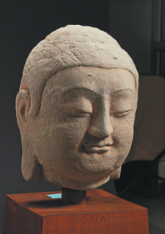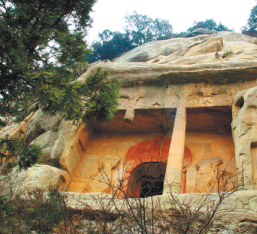Returned Buddha head debuts on Spring Gala broadcast
Updated: 2021-02-26

The Buddha head sculpture is the 100th cultural relic item retrieved by China from overseas in 2020. [Photo/China Daily]
A Buddha head sculpture was shown for the first time on State broadcaster China Central Television's Spring Festival Gala on Feb 11, marking its first public appearance after its return from Japan two months ago.
The stone Buddha head, stolen from one of the statues in Tianlongshan Grottoes in North China's Shanxi province and smuggled to Japan nearly 100 years ago, was brought back to China on Dec 12, Xinhua News Agency quoted the National Cultural Heritage Administration as saying.
The NCHA said it was the 100th cultural relic item retrieved by China from overseas in 2020.
The administration first identified the Buddha head in September 2020 as a relic from Tianlongshan Grottoes in the suburbs of Taiyuan, capital city of Shanxi province, when the sculpture resurfaced at a Japanese auction house.
Tianlongshan Grottoes, 36 kilometers to the southwest of Taiyuan, is notable for the Buddha statues in its 25 caves. Construction of the grottoes began in the Eastern Wei Dynasty (534-550) and continued until the Tang Dynasty (618-907).
In the 1920s, a large number of statues-over 240, according to the NCHA-were stolen from the grottoes and smuggled overseas, and are currently housed in museums in Japan, Europe and the United States, or have been obtained by individual foreign collectors.
After identifying the to-be-auctioned Buddha head to be a relic from Tianlongshan, the NCHA contacted the auction house and required a halt to the sale, according to Xinhua reports.
The most fortunate thing about the Buddha head is that Zhang Rong, board chairman of the auction house, is a Chinese national. In late October, after buying the Buddha head from the Japanese collector, Zhang decided to donate the sculpture to the Chinese government, Xinhua reported.
"Purchasing the relic was the simplest way to bring it back to China, instead of conducting lengthy negotiations with the foreign collector," Zhang told Xinhua.
Zhang said as a Chinese citizen, his action in helping to retrieve the sculpture was driven by patriotism.

An external view of Cave 8 in Tianlongshan Grottoes in Shanxi, where the sculpture was stolen in around 1924. [Photo/China Daily]
Examinations and evaluations conducted by experts after the Buddha head arrived in Beijing found that the relic had been stolen from a statue in Cave 8 of the grottoes in around 1924.
After its public debut on CCTV, the Buddha head is being exhibited at the Beijing Luxun Museum.
On Feb 16, Hang Kan, a professor of archaeology at Peking University, and head of the Yungang Grottoes Academy, held a seminar at the museum to share with audiences his insights into the historical, cultural and artistic values of the sculpture as well as the Tianlongshan Grottoes.
He said the grottoes were built during the period from the warring Northern Dynasty (386-581) to the prosperous Tang Dynasty and this was also a period featuring the localization of Buddhist arts.
He suggested audiences pay special attention to the facial expression of the Buddha head.
"Seen from every angle, the Buddha presents a smiling expression. This is a show of confidence identical to a prosperous period like the Tang Dynasty," Hang said.
The Buddha head will return to Tianlongshan Grottoes after exhibition and research work is finished in Beijing, according to Yu Hao, head of Tianlongshan Grottoes Museum.
The official said the Buddha head will not be returned to its original body as the body is no longer intact because of weathering and water erosion. Instead, it will be displayed at the museum.
Guo Yanjie contributed to this story.



